Why Remember The Milk is the best to-do app?
Are you always looking for the best to-do app to organize your life? After years of experimenting with numerous to-do apps, many have found an application that offers more features and is more versatile than any other application. That application is Remember The Milk.
Remember that Remember The Milk may also be the option for you, if you are looking for an application that is better than the one you are using. However, first of all, it's important to know whether the reason people think Remember The Milk is the best to-do app is the same as your case.
Let's compare the best to-do apps!
In this article, we will discuss the factors that increase the efficiency and productivity of the following workers:
- Easy to organize child list in main projects
- Set start date, completed due date and periodic tasks
- Dashboard helps you prioritize important tasks
- Integration with other online applications
Remember The Milk will be compared to the following popular to-do apps:
- Wrike
- Any.do
- Todoist
- Microsoft To-do
- Google Tasks
Think of Google Tasks as a to-do application that may not be suitable, but it is included in this list only for comparison and shows why both Google Tasks and Microsoft To-Do are far behind applications. other uses.
Compare Remember The Milk and current popular to-do apps
- Create (organize) child lists easily
- Organize the sub-list in Remember The Milk
- Child list in Microsoft To-Do
- Child list in Wrike
- List of children in Any.do
- List of children in Todoist
- Sub-list in Google Tasks
- Due dates and periodic tasks
- Periodic tasks in Microsoft To-Do
- Recurring tasks in Wrike
- Recurring tasks in Any.do
- Recurring missions in Todoist
- Google Tasks has no recurring tasks
- Control panel to set priority for work
- Microsoft To-Do dashboard
- Wrike control panel
- Control panel of Any.do
- Todoist control panel
- Google Tasks has no control panel
- Integration with other applications
Create (organize) child lists easily
One of the most hard-to-find features on most to-do apps tested over the past few years is organizing child projects. Nearly every to-do application uses the same way when structuring many to-do lists.
Organize the sub-list in Remember The Milk
At first, Remember The Milk seems to be missing this feature because the application's approach is: An item will open a single list. There is no option for the sublist.
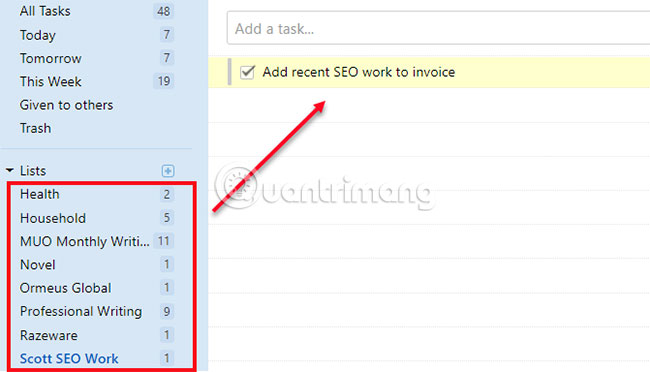
However, this is wrong. With Remember The Milk, you need to sort multiple lists in one 'directory' using tags.
For example, most of your time is for tasks sent randomly by customers. You can organize these sublists in the 'Subclient Work' folder .
You do this by creating a tag to sort multiple lists.
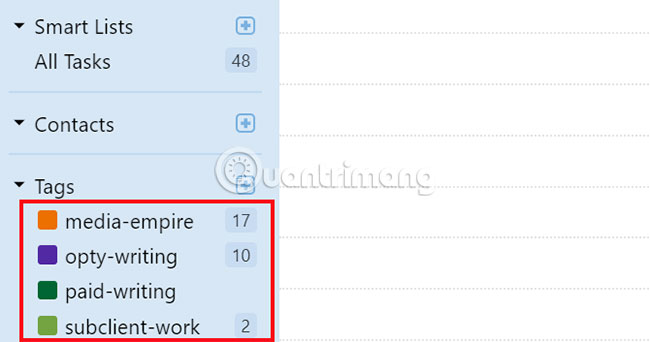
Then you just need to tag individual tasks and arrange them under the main subheadings. You can even create a new card if you don't have one yet.
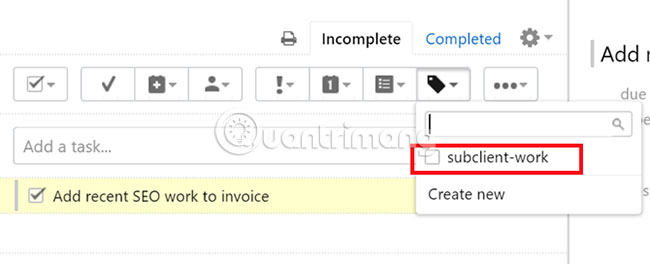
Now, let's see what other to-do apps do this feature.
Child list in Microsoft To-Do
Microsoft To-Do cannot do this. You can create individual lists, but there is no way to group these tasks into projects.
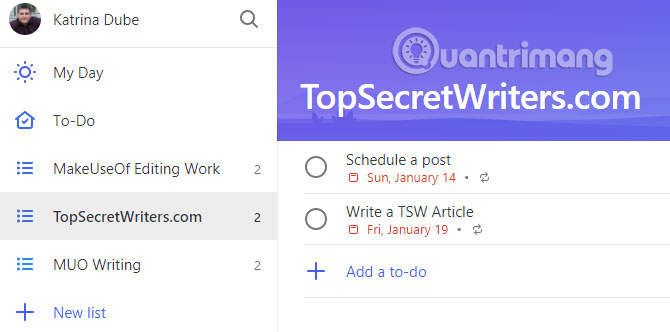
Child list in Wrike
This is the aspect that makes Wrike truly the best to-do app. It allows you to create a directory to group the top level projects.
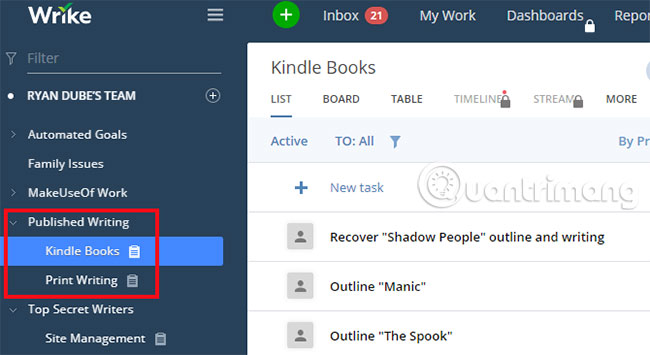
This is what to-do lists should include. It seems ridiculous that most to-do applications do not provide directory organization for the project.
So if this feature is your biggest priority, Wrike may be the right choice for you. However, there are other areas where Wrike is lacking, so read through the rest of the article, talk about the features below, before you make a final decision.
List of children in Any.do
Among the to-do apps, Any.do is probably one of the worst tools when it comes to organizational functionality. Any.do seems to only convert the to-do list from traditional to Kanban (card-based) approach.
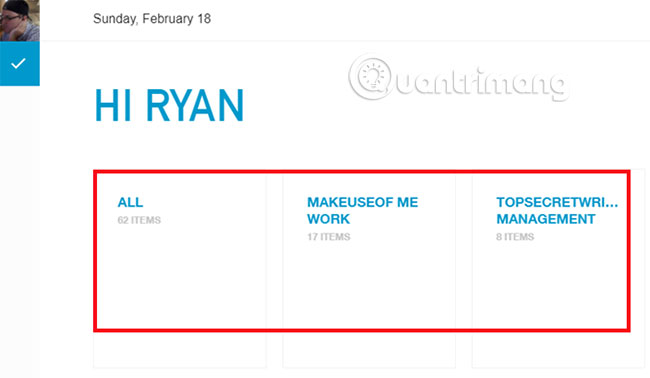
Each main card opens a list of tasks, organized over time when they are due (today, tomorrow, upcoming or someday).
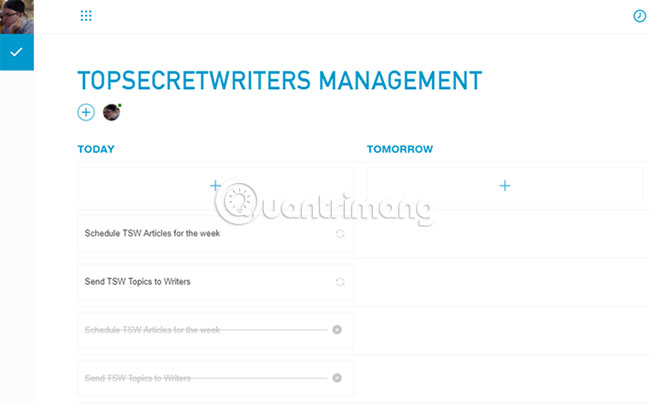
This is an effective method for many people, but most suitable for someone who has a task or role in life and they need to organize everything according to that role.
If you hope to organize many areas or projects, serve many different goals in life, then Any.do is not for you. There is no way to organize child lists according to big projects with Any.do.
List of children in Todoist
Todoist is a favorite to-do application of many people for a long time, and this feature is one of the reasons why. With Todoist, you can indent sub-projects to group them according to major projects or you can label tasks.
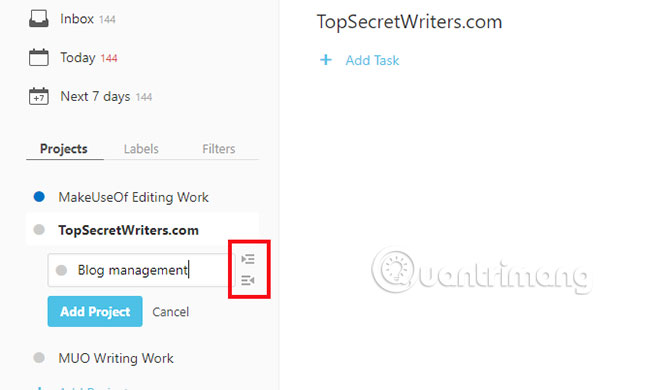
This means that you can not only create sub-projects, but you can also create smaller projects for your main content. If you like to consolidate tasks within multiple subdirectories, then this works as you expect.
One thing that makes this application weaker than Remember The Milk is that unlike the tagging method, this indentation method is somewhat manual and time-consuming. However, Todoist allows you to label tasks.
Sub-list in Google Tasks
Although as mentioned above, considering Google Tasks is a to-do application that is not very suitable, but at least it allows you to indent tasks below the main tasks. However, Google Tasks does not have a sub-set feature below individual projects.

As you can see, there are a few to-do apps that provide this feature, but those applications are quite manual and difficult to manage. Wrike does this best, literally, giving you the ability to put projects into folders. Instead, Remember The Milk automates organization into subfolders, by allowing you to organize items with high-level tags.
Due dates and periodic tasks
One of the main reasons many people switch to Remember The Milk is because it handles schedules and due dates for pretty good tasks. This is an important part of time management.
This feature is quite good for managing tasks once, but when you handle some tasks that take days to complete, only the due date is not enough. You need to care about the start day too.
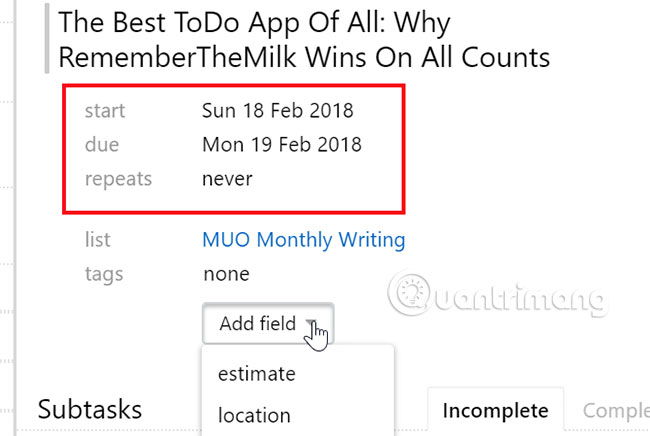
This helps you create large enough gaps in the schedule to handle the real 'depth' of the task.
Another important feature to create an effective to-do application is the ability to create recurring tasks.
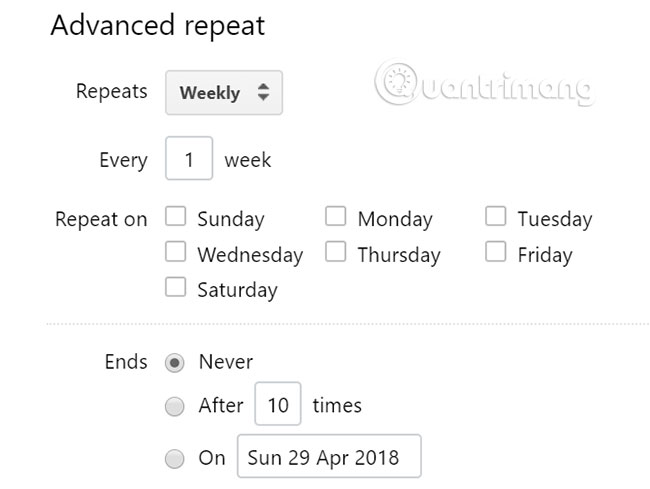
Remember The Milk's ability to create recurring tasks is very flexible. Not only can you set up complex patterns daily, weekly, monthly or yearly, but you can even set up tasks to repeat again as soon as you complete it.
Periodic tasks in Microsoft To-Do
Although quite simple and lacking most features, Microsoft can at least create periodic tasks.
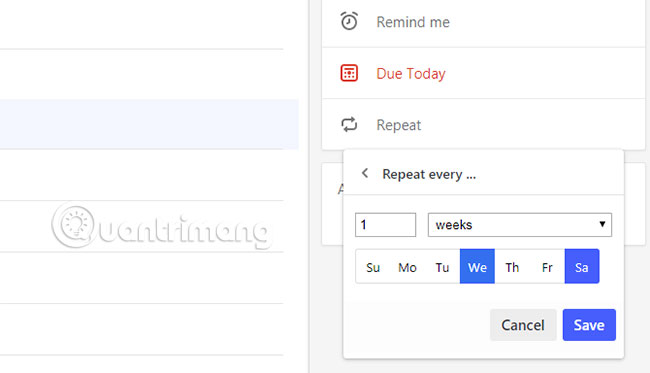
In Microsoft To-Do, you can set tasks to repeat every day or several times a week, month or year. There is no option to repeat when a task is completed.
Recurring tasks in Wrike
As with most other features, Wrike is a bit more flexible than most other to-do applications. Wrike not only provides standard daily, weekly, monthly and yearly standard options, but also allows you to stop repeating tasks after a certain number of triggers. You can also delay the start of the first iteration.
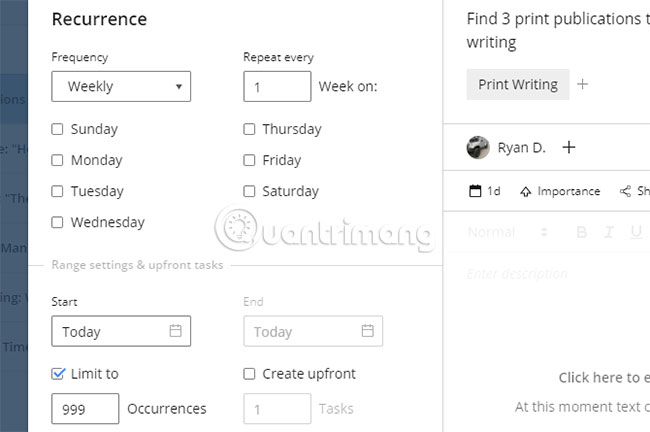
Like most other to-do apps, there is no option to repeat the task immediately after completion, like Remember The Milk.
Recurring tasks in Any.do
Although the project organization feature of Any.do has many things to improve, but at least it allows to perform periodic tasks.
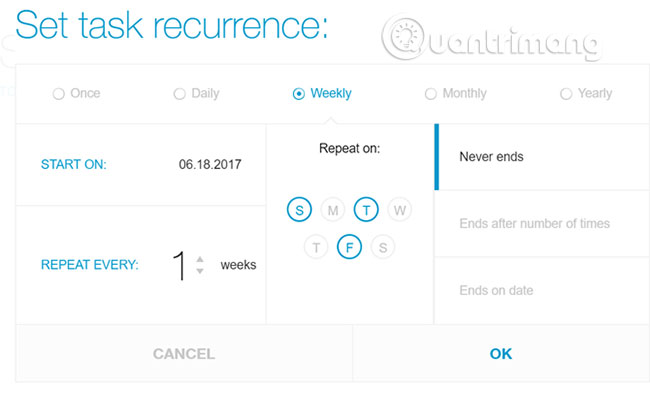
Like Wrike, Any.do has the option to stop repeating after a certain number of triggers or after a specific date. Again, there is no option to repeat immediately after completion.
Recurring missions in Todoist
Todoist is a must-have app for many years and one of the reasons is the use of simple English commands to create fairly intelligent recurring tasks.
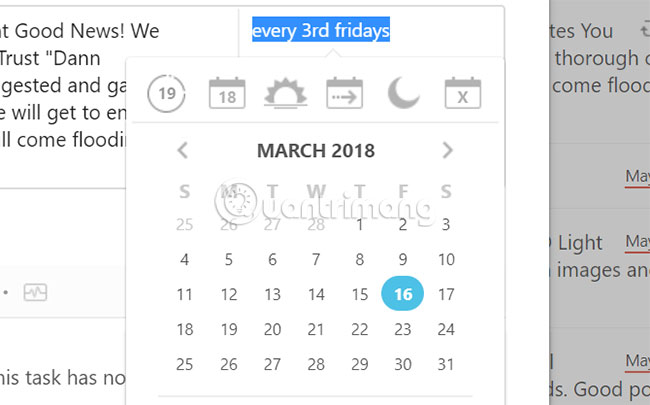
You can enter something, such as 'every 3rd Friday', and Todoist is smart enough to set the next due date on the third Friday of the current month and each month after that. Todoist understands many different 'variations' of the schedule.
The only problem with Todoist is that when a task is completed, it is not always reorganized on the next day. This makes many people miss the due date of some tasks and urges them to find a new application instead.
Google Tasks has no recurring tasks
You absolutely cannot create recurring tasks in Google Tasks. This is one of the applications that Google needs to improve more in the future.
Control panel to set priority for work
The number one feature for many people when using any to-do app is the ability to quickly see the day or week and understand which tasks need top priority. Some applications do this great. But some other tools do not. Let's review Remember The Milk first.

Remember the Milk gives you a number of views, giving you a quick overview of your week or day. The 'This Week' favorite view, which shows you all the tasks you have from Saturday to Sunday. This makes moving tasks much easier, making the week's workload better adjusted.
Next, see what all other to-do applications are missing in this respect.
Microsoft To-Do dashboard
Microsoft To-Do has no control panel. All Microsoft To-Do offers is the 'My Day' view, which shows you the due dates completed today.
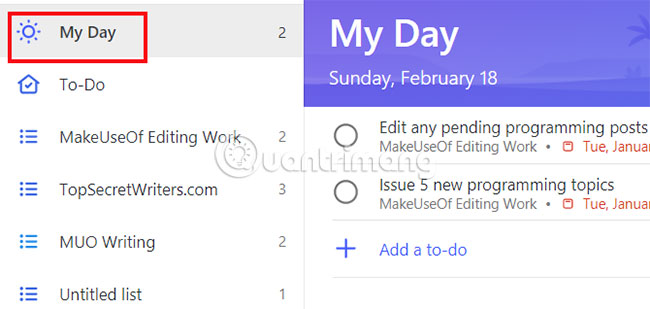
This is useful when you are trying to plan ahead for work, avoiding having to deal with a crisis of conflict of priority tasks on the same day.
Wrike control panel
Wrike uses an interesting approach for tasks in the control panel. Wrike groups tasks by today ( Today ), this week ( This Week ), next week ( Next Week ) and then ( Later ).
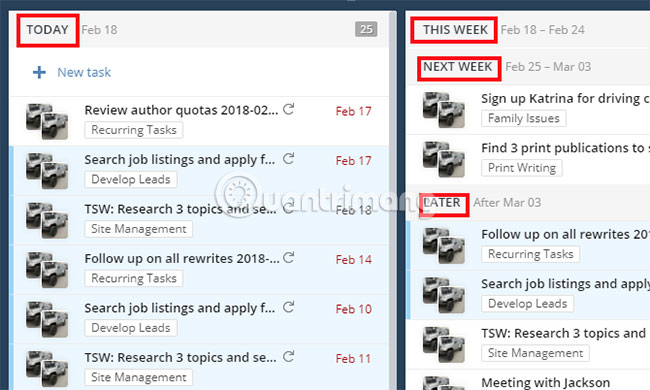
All groups are displayed (although there is no other type of view to choose from) and it is still a useful way to organize tasks. You can see the upcoming tasks in the future, helping you change things to prioritize. At the same time, you also know all the tasks of today, requiring you to pay attention immediately.
One problem that users encounter with Wrike is that it is built to team collaboration. This means that the task needs someone to appoint. If you use Wrike as an individual and forget about yourself as the task assignor, the task will not be displayed under 'My Work', and you may miss the task. important. The applications that need to make the group have their own place, but for personal project management, they are not really relevant.
When moving a task between project folders, that task will not appear in the to-do list today. However, Wrike's customer support assumes that this is normal. The due date is still listed today but is not displayed in the 'Today' section, so this explanation is not acceptable. This error causes many users to miss tasks. This is the main reason why they decided to abandon Wrike permanently.
Control panel of Any.do
As mentioned earlier in this article, Any.Do uses a Kanban-style system where tags can be switched between projects and the due date is completed.
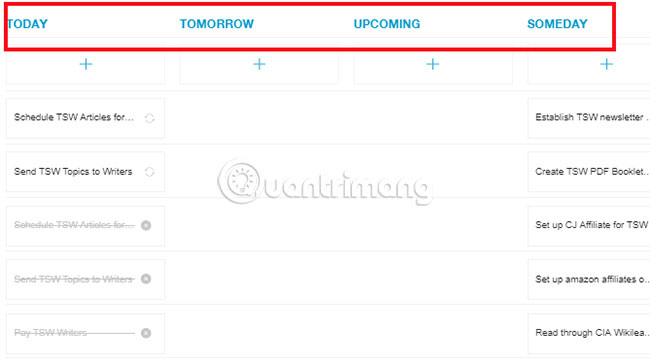
So you can easily transfer a task from today to tomorrow by dragging the task card to tomorrow.
The problem with this panel is that all the tasks are listed tomorrow, coming up and someday not being displayed when they are due, so it is difficult to plan for future work. If not, open a personal task card and check the due date for completion. This is a very cumbersome setting. Obviously, Any.Do is trying to create a minimalistic control panel, but it is so minimalist that it creates a system that cannot be used.
Todoist control panel
This is an area where Todoist deserves to receive bonus points. Todoist provides the ability to view tasks for today ( Today ) and the next 7 days ( Next 7 days ).
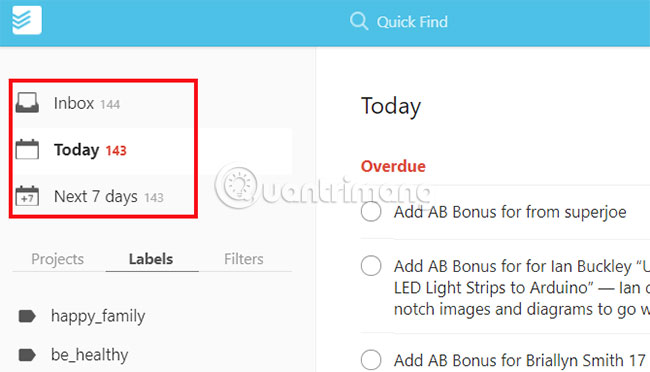
In the list view on each screen, tasks display the due date and the project they are in. This makes organizing daily and weekly work very easy.
Google Tasks has no control panel
Not surprisingly, Google Tasks also lacks this feature. You can arrange tasks in individual projects by the due date of completion, but cannot organize the entire list of project-based tasks in the order of due dates. You certainly cannot group them by today, week or month.
Integration with other applications
The last thing you want is a to-do application that is not separate from the rest of the world. One of the most effective ways for an application to be made becomes more efficient than automating everything.
For example, when you complete a task in a certain project, you want to automatically email your manager with details. Things like this can be done with to-do applications that integrate with services like Zapier or IFTTT.
This is an analysis of the integration capabilities of the to-do applications considered in this article.
Integration with IFTTT:
- Remember The Milk
- Todoist
Integration with Zapier:
- Remember The Milk
- Todoist
- Wrike
Integration with Slack:
- Todoist
- Wrike
- Any.do
Add tasks via email:
- Remember The Milk
As you can see, even in terms of integrating with other services, Remember The Milk is still the first choice.
At the present time, you have considered all the differences between top to-do apps, but don't stop there! It's time for you to decide on one of these applications. Hopefully, the above overview information will help you make the right decision.
Wish you find yourself the right choice!
You should read it
- The mistake when drinking milk turns it into a poison in the body
- Should drink milk at the best time
- Did you know: What is condensed milk made for?
- [Troubleshooting] Common questions when making soy milk
- 10 great benefits of drinking milk every day
- Choose a grain milk maker is good for the family?
- Surprisingly, a Japanese company has completely made music players in milk cans
- Instructions for making healthy cocoa bean milk
May be interested
- Beautiful Milk Tea Background, download Beautiful Milk Tea Background here
 beautiful milk tea background. you are thinking of advertising ideas for a milk tea shop but have not found a satisfactory image for advertising? with the milk tea background samples in this article, you will easily select and find the image you like.
beautiful milk tea background. you are thinking of advertising ideas for a milk tea shop but have not found a satisfactory image for advertising? with the milk tea background samples in this article, you will easily select and find the image you like. - Which type of soy milk maker should I buy?
 what kind of soy milk maker? this is probably one of the questions that many housewives are trying to answer.
what kind of soy milk maker? this is probably one of the questions that many housewives are trying to answer. - Video: Flamingoes feeding their babies with 'red milk' surprised many people
 many viewers were shocked when they first witnessed this scene because at first glance it seems that the mother flamingos had ripped open the head of another adult flamingo so that the offspring would drink the same blood. however the truth is not as scary and scary as what people see.
many viewers were shocked when they first witnessed this scene because at first glance it seems that the mother flamingos had ripped open the head of another adult flamingo so that the offspring would drink the same blood. however the truth is not as scary and scary as what people see. - Which type of milk heater should be used between Fatzbaby and Philips AVENT?
 featured in the fan brand names must include two names: fatzbaby and philips avent. however, which of these brands should i use? let's go with quantrimang to find the answer.
featured in the fan brand names must include two names: fatzbaby and philips avent. however, which of these brands should i use? let's go with quantrimang to find the answer. - How is breast milk preserved after being squeezed?
 how to store milk properly to keep your baby's nutrients in place.
how to store milk properly to keep your baby's nutrients in place. - How to make crispy fresh milk cake
 crispy fresh milk cake is a delicious snack that is loved by many people. how to make freshly fried milk cake is very simple, you can refer to the below method to make delicious cakes for your family.
crispy fresh milk cake is a delicious snack that is loved by many people. how to make freshly fried milk cake is very simple, you can refer to the below method to make delicious cakes for your family. - How to make nut milk with a delicious, nutritious blender
 in this article, tipsmake.com will show you how to make nut milk with a blender that is both simple and delicious and nutritious.
in this article, tipsmake.com will show you how to make nut milk with a blender that is both simple and delicious and nutritious. - Should buy grain milk maker? Which grain milk maker is good?
 keep track of our article below to consider whether to buy a grain milk maker or not and which type of grain milk maker to buy!
keep track of our article below to consider whether to buy a grain milk maker or not and which type of grain milk maker to buy! - Joyoung soy milk maker of the country? Is that good?
 the article below, quantrimang will help you understand which joyoung soybean milk maker and which is good?
the article below, quantrimang will help you understand which joyoung soybean milk maker and which is good? - The dishes make you admire the creativity of Japan
 these are 3 dishes and drinks that are creating a fever not only in japan but also in vietnam.
these are 3 dishes and drinks that are creating a fever not only in japan but also in vietnam.










 How to count down events on Windows 10
How to count down events on Windows 10 How to use Z1 CryptNow to encrypt data on Windows 10
How to use Z1 CryptNow to encrypt data on Windows 10 10 tips to turn Microsoft To-Do into a task manager
10 tips to turn Microsoft To-Do into a task manager How to send messages from Android phones on PC
How to send messages from Android phones on PC How to translate photos and voices on Windows 10
How to translate photos and voices on Windows 10 DuckDuckGo or Google is the best search tool for you
DuckDuckGo or Google is the best search tool for you